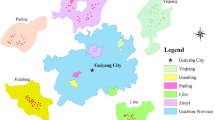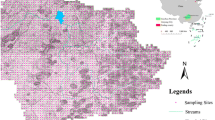Abstract
Urban soil, forming along with the development of city, has unique properties of soil organic carbon. On the basis of field investigation and laboratory analysis, soil organic carbon (SOC) of Kaifeng city was studied, and the results showed that the characteristics of SOC were different not only among function districts in urban area, but also between urban area and suburbs. The order of SOC in topsoil was industrial district > recreational district > traffic district > cultural/educational district > residential/administrative district. The density of soil organic carbon (SOCD) in both topsoil and profile followed the orders of recreational district > industrial district > traffic district>cultural/educational district > residential/administrative district, and cultural/educational district s>traffic district>industrial district>recreational district > administrative/residential district, respectively. SOCD in both topsoil and profile decreased along the transection line from urban area to suburbs and urban area had 2.53-fold more SOCD in topsoil and 1.56-fold more SOCD in profile than suburbs, respectively. SOC decreased with the depth and was mainly distributed within the scope of 0–30 cm. The variances of SOC in urban area were more complicated than that in suburbs.
Similar content being viewed by others
References
Banat K M, Howari F M, Al-Hamad A A, 2005. Heavy metals in urban soil of central Jordan: Should we worry about their environmental risks? Environmental Research, 97(3): 258–273.
Batjes N H, 1996. The total C and N in soils of the world. European Journal of Soil Science, 47(2): 151–163.
Beyer L, Lahle P, Kretschmer H et al., 2001. Soil organic matter composition of man-impacted urban sites in north Germany. Journal of Plant Nutrition and Soil Science, 164(4): 359–364.
Bian Zhenxing, Wang Qiubing, 2003. Study on urban park soil nutrients in Shenyang city’s green areas. Chinese Journal of Soil Science, 34(4): 284–290. (in Chinese)
Bullock P, Gregory P J, 1991. Soils in urban environment. London: Blackwell Scientific Publications, 1–192.
De Kimple C R, Morel J L, 2000. Urban soil management: A growing concern. Soil Science, 165(1): 31–40.
Duan Yingqiu, Wei Zhongyi, Han Chunlan et al., 2008. Content of organic carbon urban soil in different land use type areas, Northeast China. Journal of Shenyang Agricultural University, 39(3): 324–326. (in Chinese)
Eswarran H E, Van Den Berg E V, Reich P, 1993. Organic carbon in soils of the world. Soil Science society of American Journal, 57(1): 192–194.
He Yue, Zhang Ganlin, 2006. Concentration and sources of organic carbon and black carbon of urban soil in Nanjing. Acta Pedologica Sinica, 43(2): 177–181. (in Chinese)
Imperato M, Adamo P, Naimo D, et al., 2003. Spatial distribution of heavy metals in urban soil of Naples city (Italy). Environmental Pollution, 124(2): 247–256.
Kirschbaum M U F, 2000. Will changes in soil organic carbon act as a positive or negative feedback on global warming? Biogeochemistry, 48(1): 21–51.
Li Yuhe, 1997. Study on the characters of formation, estimation of fertilizer, utilization and management of urban soils. Journal of Chinese Landscape Architeture, 13(3): 20–23. (in Chinese)
Liu Yuyan, Liu Min, Liu Haofeng, 2006. Analysis on characteristics of heavy metal pollution in urban soil. Chinese Journal of Soil Science, 37(1): 184–189. (in Chinese)
Ljung K, Otabbong E, Selinus O, 2006. Natural and anthropogenic metal inputs to soils in urban Uppsala, Sweden. Environmental Geochemistry and Health, 28(4): 353–364.
Lu Ying, Gong Zitong, Zhang Ganlin, 2001. Preliminary study on characteristics and classification of soils in Nanjing city. Soils, 33(1): 47–51. (in Chinese)
Nanjing Institute of Soil Science (NISS), Chinese Academy of Sciences, 1978. Analysis of the Physical and Chemical Characters of Soil. Shanghai: Science and Technology Publishing House, 273–287.
Nelson D W, Sommers L E, 1975. A rapid and accurate method for estimating organic carbon in soil. Proceedings of the Indiana Academy of Science, 84: 456–462.
Pan Genxing, Li Lianqing, Zhang Xuhui, 2002. Perspectives on issues of soil carbon pools and global change: With suggestions for studying organic carbon sequestration in paddy soils of China. Journal of Nanjing Agricultural University, 25(3): 100–109. (in Chinese)
Phillip J C, 1992. Urban Soil in Landscape Design. New York: John Wiley and Sons Inc., 85–122.
Post W M, Emanuel W R, Zinke P et al., 1982. Soil carbon pools and world life zones. Nature, 298(8): 156–159.
Pouyat R, Groffman P, Yesilonis I D et al., 2002. Soil carbon pools and fluxes in urban ecosystems. Environmental Pollution, 116(1): 107–118.
Pouyat R V, Yesilonis I D, Golubiewski N E, 2008. A comparison of soil organic carbon stocks between residential turf grass and native soil. Urban Ecosystems, 12(1): 45–62.
Raich J W, Potter C S, 1995. Global patterns of carbon dioxide emissions from soils. Global Biogeochemical. Cycle, 9(1): 23–26.
Rawlins B G, Vane C H, Kim A W et al., 2007. Methods for estimating types of soil organic carbon and their application to surveys of U K urban areas. Soil Use and Management, 24(1): 47–59.
Richard V P, Yesilonis I D, David J N, 2006. Carbon storage by urban soil in the United States. Journal of Environmental Quality, 35(4): 1566–1575.
Rodriguez-Murillo J C, 2001. Organic carbon content under different types of land use and soil in peninsular Spain. Biology and Fertility of Soils, 33(1): 53–261.
Schlesinger W H, 1990. Evidence from chronosequence studies for a low carbon-storage potential of soils. Nature, 348: 232–234.
Williamm R E, Richard V P, 1997. The genesis, classification, and mapping of soils in urban areas. Urban Ecosystems, 1(4): 217–228.
Wu Xinmin, Li Lianqing, Pan Genxing et al., 2003. Soil pollution of Cu, Zn, Pb and Cd in different city zones of Nanjing. Chinese Journal of Environmental Science, 24(3): 105–111. (in Chinese)
Xiong Yi, Li Qingkui, 1978. Soils in China. Beijing: Science Press, 39–303. (in Chinese)
Zhang Ganlin, He Yue, Gong Zitong, 2004. Characteristics of organic carbon distribution in anthropogenic soils and its implication on carbon sequestration. Quaternary Sciences, 24(2): 149–159. (in Chinese)
Zhang Ganlin, Zhu Yongguan, Fu Bojie, 2003. Quality changes of soils in urban and suburban areas and its eco-environmental impacts: A review. Acta Ecologica Sinica, 23(3): 539–545. (in Chinese)
Zhang Jia’en, 1997. The formation and protection of urban soil. Soils, (4): 189–193. (in Chinese)
Zhang M K, Ke Z X, 2004. Heavy metals, phosphorus and some other elements in urban soil of Hangzhou city, China. Pedosphere, 14(2): 177–185.
Zhang Mingkui, Zhou Cui, 2006. Characterization of organic matter accumulated in urban soil in the Hangzhou city. Chinese Journal of Soil Science, 37(1): 19–21. (in Chinese)
Author information
Authors and Affiliations
Corresponding author
Additional information
Foundation: Key Scientific and Technological Research Projects of Henan Province, No.72102150029
Author: Sun Yanli (1979–), Ph.D, specialized in soil environment.
Rights and permissions
About this article
Cite this article
Sun, Y., Ma, J. & Li, C. Content and densities of soil organic carbon in urban soil in different function districts of Kaifeng. J. Geogr. Sci. 20, 148–156 (2010). https://doi.org/10.1007/s11442-010-0148-3
Received:
Accepted:
Published:
Issue Date:
DOI: https://doi.org/10.1007/s11442-010-0148-3




